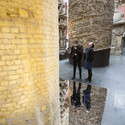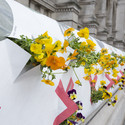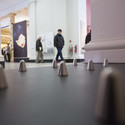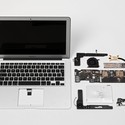The Victoria and Albert Museum (V & A), the name of the Queen and her Consort, has its bases in the Great Exhibition of 1851 in the midst of wealth, innovation and misery of the industrial revolution. Britain was flooded by the prosperity that has enabled the development of new large institutions to collect and present objects of cultural significance or artistic value. first director of the institute, Henry Cole, said there should be "a classroom for everyone," and a democratic approach to its relationship with public life has remained the cornerstone of the V & A. Not only it has always been free, but it was also the first to open late hours (enabled by gas lighting), which allows a more complete demographic of visitors. Their latest exhibition, which opens today, will realign the extensive collection and exhibition center South Kensington museum spaces with these fundamental concepts. the interventions of this is for you attempt to push the position of the V & a as an extension of the built environment and cultural civic London in front, testing the museum's ability to act as a public institution of the 21st century. to do this in London, a city where the notion of public and private is increasingly blurred, resulting in a sequence of compelling installations which are interconnected through either their relevance, technical, or timely. The presence of the V & A street is deep. Standing in front of its main entrance, the facade seems to stretch far into the distance either way, mixing in the natural history museum in one direction and shifting down in the terraces of rows in the other. Here, however, is where the first interventions in the context of This is for you is. Natalie Jeremijenko is the founder of the Environmental Health Clinic at the University of New York. For his project, which covers both science and public art, she placed "AgBags" - Advanced grow bags of his own invention - the large stone parapets at the museum entrance. Its installation takes existing inner-city structure to create arable land - almost out of thin air. These porous bags, made from a synthetic felt called Tyvek, let the compost inside breathe while remaining waterproof. Their front design allows them to be draped on any railing or wall; . Railing before the V & A is the last test metropolitan site However, this begs the question: what do you cultivate in a London street busy? Jeremijenko argues that "most enthusiastic urban gardeners think agriculture is on vegetables." Here is the evidence that this could not be further from the truth. Flowers that have a nutritional and commercial value both high, are also important pollinators. "Although highly perishable," says Jeremijenko, "flowers are the most dense in nutrients things we know" and are particularly important for the ecology of urban housing in a crisis pollen. It recognizes that in the city "there is a whole cultural challenge on how you maintain, integrate and encourage flowers" and these interventions are part of a global study. Along with this, she placed a clock in phenological the grand entrance of the museum, it is the face representing twelve months in the life cycle of fluids plants and pollinating insects around the building. the cast courts the V & A are some of the most beautiful areas within the . museum Simply, they are huge ships 1: 1 plaster models and the reliefs of the "hits" of the Grand Tour, all gathered in one place. Not only that part of the reference collection directly widest democratic vision of the institution itself, but it also marks the founding of a vast collection of museum architecture, which originally started as an aid the large-scale education and is now the largest in the world. Here This is for you away from urban ecology to conservation and preservation as ephemeral ghost column "Jorge Otero-Pailos'. The largest piece in the Cast Courts is a replica of Trajan's Column (AD 113), painstakingly reproduced by craftsmen in Rome before being transported and erected in two parts back in London in the mid-19th century. Because of their size, and to stand up, they were attached to a brick chimney that was invisible - hidden in plaster - since 1867. Curator of Contemporary Architecture and Urbanism Rory Hyde guests Otero-Pailos professor the Columbia Graduate school of preservation and planning (GSAPP), to reveal the hidden structure using a method he has experienced before. "conservation Latex" was applied in liquid form to the curved inner wall of the chimney structure. dry then was left thoroughly before being removed. This huge piece of plastic fabric was suspended and thereby revealed the hidden structural interior of the adjacent brick plaster column. Here, in an object, three time points were aligned in a contemporary continuity between the original column, the plaster copy, and this "new" area of accumulated dust and pollution. Hyde, this intervention, particularly talking about the intrinsic right of care of a museum is its collection. "If This is for you ," he said, "then look after us better." "On the one hand [the museum] needs to keep these things physically intact, but if they are not relevant or central to think they become more vulnerable in another way: they become easier to get rid of because they are not more important to us "He speaks of it as a form of" conceptual conservation ", reviving the Cast courts. reintroducing new ways of thinking about objects. The plaster casts "recall a period of time where authenticity was not important. Here we try to highlight the artifice while trying to recover some relevance. " The potential impregnated with this approach is revealed most clearly in Ways to be public , a exhibition of drawings, photographs and images selected and assembled by Hyde himself. It starts with the assumption that the public space is in some form of crisis - our traditional commitment to the public square, green community, or common land has been eroded. "Largely due to the technology of the 20th century," Hyde says. "Our traditional connection to a place or a specific community is also critical that the various networks that we can build independent of it" Architects, whose work is to give meaning through space, have responded to this development in several ways; the purpose of this exhibition is to defeat and collect the tactics and types of new spaces being created Among the images as OMA flag for Europe (01), which distends each flag of the European Union in a sliced barcode different identities of the nation under one umbrella graphics and photographs of the earth above the Large Hadron Collider, which straddles the border between France and Switzerland, the theme becomes evident on a variety of different scales. - the continent in the area and everything in between - it becomes clear that the question of public space is a deeply political. The photographs of Trevor Paglen of NSA in Maryland buildings speak of the sinister side to invisible networks that we have integrated into our daily lives, while visual Studies in London Henrietta Williams steel ring "refer to the physical manifestation this threat, after the fear, and inevitable urban attempts to control through the seemingly innocuous devices ponds and ornamental trees. Also indicative of this idea are two drawings, opposite to the other set. one, the reflective plane of David Chipperfield Architects Neues Museum 1:10 Berlin ceiling is marked by hundreds of scribbles and notations. Restaurateurs, heritage consultants, architects and engineers, each incremental describes what parts of the building to restore that to protect, which to replace, and to improve structurally. That compares with drawings of Mies van der Rohe Neue Nationalgalerie (the same city), in which a bold new architectural typology has been used to attempt to redefine a nation. As Hyde said, "it is essentially an empty container for the public to fill in and define their future; the other tries to do the same by thousands of tiny decisions. Both are trying to create new beginnings while struggling with the physical and psychological damage of the past " Hyde points out a small paper printed 1682 :. A warrant of King Charles II restored the independence of the city of London as a place of negotiation. "It is a piece of paper that has dramatically changed the architecture - I see it as a bottleneck in history." In the same vein, the collection ends with a picture of Julian Assange (WikiLeaks), speaking from the balcony of the Ecuadorian Embassy. "It is physically the police reach," notes Hyde, "but made immune by this piece of architecture where the real intersection area with diplomatic law." Pieces of Assange MacBook, which were disclosed to The Guardian newspaper before being symbolically destroyed by the British government, are now on display in ways 'secret be (organized by Corinna Gardner). From the point of view of Hyde, the events surrounding this object must also be described as a bottleneck in history. By exposing objects such as this, the V & A actively cultivate a discussion formalized through the lens of the museum collection. Hyde continued, "somehow this whole thing is over networks - the idea of flight, and the power it can have in the transformation of the city and the world We have placed [the photo of Assange] here - without trial. -.! As a kind of "full stop" Other items on display include architecture / art project entitled More a (fragile) muf thing at a time. They host a series of activities, all caused by the existing contents of the gallery and beyond places these objects come. In addition, twenty-five civic objects were placed around the V & A pertaining to the theme of the exhibition. From a security point used in the London Olympics in 2012, with anti-immune spikes embedded between two columns, these objects are intended to illustrate the close relationship between design and public life. Read more about the exhibition here. The V & A is open daily from 10.00 to 17.45 and until 22:00 on Friday.



 9
9
Review: 'All Of This Belongs To You' - Civic Urbanism At Victoria & Albert Museum
Save this picture [1945006!]
Save this picture! installed
Save this ! photo
Save this picture!
Save this picture!
Save this picture
Save this picture!
Save this picture!
Posting Komentar